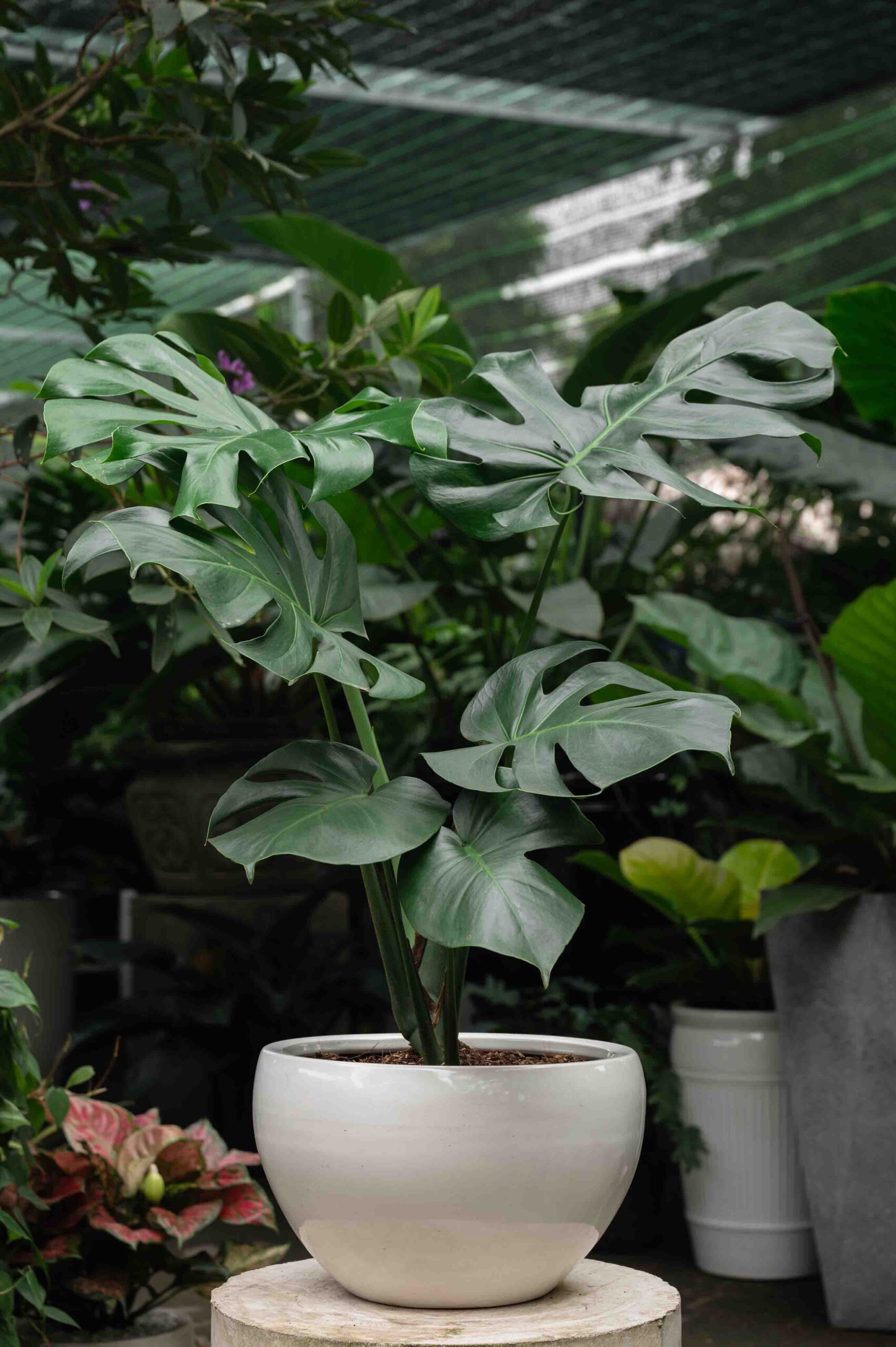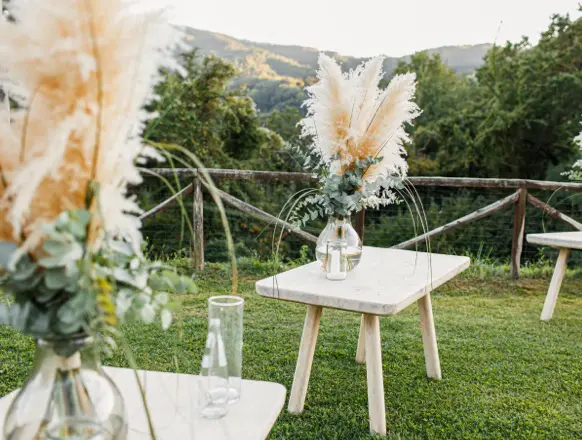Ornamental plants are plants with unique and beautiful leaf shapes and colors, and are loved by many people to grow in their homes, gardens or offices. Ornamental plants not only beautify the living space, but also purify the air, improve mood and bring feng shui meaning to the homeowner. However, in order for ornamental plants to always be green and grow well, you need to pay attention to some important factors during plant care. This article will guide you how to care for indoor ornamental plants in the most effective and simple way.

Small Monstera tree at Phuc Garden
- Provide enough water for the plant
Water is an essential element for plant life and growth. Depending on the type of plant, you need to provide enough water for the plant without causing waterlogging or drying out of the soil. You can look at the soil surface or press the soil with your hand to feel the soil moisture. If the soil is dry and cracked, you should water the plant. If the soil is moist and there is runoff, you should reduce the amount of watering. You should use clean water, at room temperature, do not use cold or hot water to water your plants. You should also choose a pot with drainage holes at the bottom of the pot to avoid water accumulation and cause root rot for the plant.
Some types of ornamental plants have high water needs and need to be watered regularly 2-3 times a week, especially in the summer months. For example, anthurium plants, anthurium plants, alocasia plants, etc. You can install an automatic watering system or self-watering pots, mist sprayers, etc. to provide moisture to the plants.
- Meet the required amount of light
Light is the energy source for plant photosynthesis. Plants need enough light to grow healthy and beautiful. However, not all plants need a lot of light. There are plants that like direct sunlight, there are plants that only need light, and there are plants that like shade. You need to learn the characteristics of each type of plant to place the pot in the appropriate location. If the plant does not have enough light, it will wilt, turn yellow, and grow slowly. If the plant has too much light, the leaves will burn, the branches will dry out, and they will lose color.
Some ornamental plants like direct sunlight and need to be placed in a place with lots of sunlight, at least 6 hours a day. For example, caladium plants, monstera plants, philodendron plants, etc. You can place potted plants on the balcony, window, terrace, or where there is artificial light
Some types of ornamental plants only need light, do not like direct sunlight, and need to be placed in a place with dim light, about 3 – 4 hours a day. For example, anthurium, alocasia, betel, etc. You can place the pot near the window, or cover it with curtains, or use a lamp for lighting.
Some ornamental plants like shade and do not need much light. They should be placed in a place with low light, about 1 – 2 hours a day. For example, honeysuckle, red banyan tree, peace lily, etc. You can place the potted plant indoors, or in a place with shade, or use fluorescent lights for lighting.
- Regularly fertilize plants
Fertilizer is a source of nutrients for plants. Plants need enough nutrients to increase resistance, stimulate flower and leaf growth, and maintain color. You should fertilize your plants periodically, depending on the type of plant and the season. You can use organic fertilizers such as chicken manure, cow manure, earthworm compost, or chemical fertilizers such as NPK, DAP, phosphorus, potassium, and micronutrients. You should dilute fertilizer with water in the appropriate ratio, do not use fertilizer that is too concentrated to avoid burning the roots and leaves of the plant.
Some types of ornamental plants need regular fertilizer, about 2-3 times/month, especially in spring and summer, when the plant is in the period of strong growth. For example, monstera plants, anthuriu plants, alocasia plants, etc. You can use organic fertilizers or chemical fertilizers with high NPK content to stimulate plants to leaf out and grow.
- Control plant pests
Pests are enemies of trees. Pests can harm plants by eating leaves, branches, flowers, roots, or secreting substances that are toxic to the plant. Pests can cause plants to weaken, lose productivity, and die. You need to regularly check the condition of the tree. If you detect signs of pests, you should treat it immediately. You can use mechanical measures such as uprooting, cutting, and removing pest-infested plant parts, or use biological measures such as raising pest-eating insects, or use chemical measures such as spraying pesticides. Pests and diseases for plants. You should choose the right pesticide for the type of pest, and follow the manufacturer’s instructions for use.
Some common pests in ornamental plants are mealybugs, scale aphids, white aphids, thrips, stink bugs, red spiders, thrips, scarab beetles, leaf rollers, rootworms,… You can get Know pests by observing symptoms such as eaten leaves, wax stains, resin stains, burn marks, twisted edges, yellowing, falling off, rotten roots, swollen roots, etc. You can Use pesticides such as abamectin, imidacloprid, acetamiprid, malathion, dimethoate, diazinon,… to prevent and treat plant pests.

The Poinciana tree at Phuc Garden is carefully cared for
- Prune leaves and branches for trees
Pruning leaves and branches is an important job in the process of caring for indoor ornamental plants. Pruning leaves and branches helps the tree to be airy, clean, and beautiful. You should prune any leaves that are yellow, dry, or infested with pests. You should also prune old, weak, or too long or dense branches. You should use sharp scissors to prune leaves and branches, and clean the scissors after use. You should prune leaves and branches in spring or fall, when the tree is in its strong growth phase.
Some types of ornamental plants can be trimmed and shaped to your liking, to increase the aesthetics and feng shui of the plant. For example, monstera plants, philodendron plants, betel plants,… You can prune plants into rectangles, circles, triangles, ovals, heart shapes, star shapes,… You can also Prune trees in the shape of animals, people, objects, etc. You should use ties, hanging ropes, or clips to help the tree maintain its pruned shape.
- Repot the plant
Repotting is necessary when the plant has grown too large for the old pot, or when the soil in the pot has been depleted of nutrients, or when the pot is damaged, cracked, or broken. Repotting helps the plant have better growing space, and is supplemented with new, nutrient-rich soil. You should repot the plant in the spring, when the plant is in its strong growth phase. You should choose a pot that matches the size and shape of the plant, it can be a ceramic pot, a plastic pot, a ceramic pot, a cement pot, a bamboo pot, a wooden pot, etc. You should choose soil with good drainage. good, can be clay soil, sandy soil, gravel soil, charcoal soil, coconut shell soil,…
To repot a plant, you need to follow these steps:
– Prepare a new pot, new soil, scissors, knife, brush, shovel, foam, lining cloth, binding wire, clean water.
– Water the plant before repoting it so it can easily be removed from the old pot.
– Turn over the old pot, use your hands or a shovel to gently remove the plant from the pot, being careful not to break the roots.
– Use a knife to cut off rotten, wormy, dry, or broken roots, leaving behind healthy and well-developed roots.
– Use a brush or your hand to remove old soil from the tree roots, so that the tree can easily absorb the new soil.
– Line the bottom of the new pot with foam or cloth to prevent tree roots from growing through the drainage hole.
– Pour new soil into the pot, use your hands to press gently so that the soil is flexible and does not collapse.
– Place the tree in the pot, use your hands to adjust the direction and depth of the tree, so that the tree is balanced and beautiful.
– Pour new soil into the pot, use your hand to gently press the soil to firmly adhere to the plant’s roots, so that the plant does not shake.
– Use tie wire to fix the tree in the pot, if the tree is too tall or too heavy.
– Water the plant after repoting it so it can recover and adapt to the new environment.
Those are the basic steps to take care of indoor ornamental plants. In addition, you can also apply some tips to increase the vitality and beauty of your plants, such as:
– Use coffee water, tea water, rice water, banana peel water, egg shell water,… to water the plants, to provide more nutrients for the plants.
– Use banana peels, egg shells, orange peels, lemon peels, garlic peels, etc. to cover the base of the tree to keep the tree moist and prevent pests.
– Use beer, milk, cooking oil, soap, vinegar, salt,… to spray on the leaves to clean and shine the leaves.
– Use popsicle sticks, plastic sticks, bamboo sticks, wooden sticks,… to make trellises for climbing plants, or to support plants to stand upright.
– Use items such as cups, bowls, vases, vases, boxes, baskets, bags, etc. to make plant pots, to create uniqueness and creativity for plants.
Hopefully this article will help you gain more knowledge and skills to best care for indoor ornamental plants. Ornamental plants are green friends of humans, they bring joy and happiness to life. Please love and protect trees, to have a fresh and green living environment. Thank you for reading Phuc Garden’s article.







